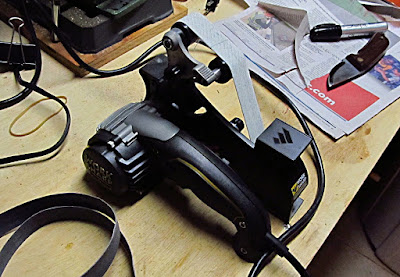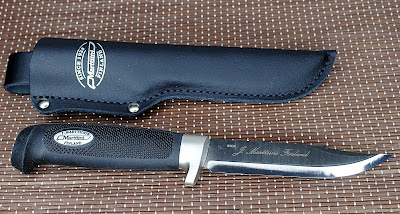I just picked up a little hawkbill folder called the Isonzo from MKM and it’s pretty cool.
MKM stands for Maniago Knife Makers a consortium of knife makers in Italy. I followed the Google links and ended up at CONSORZIO COLTELLINAI MANIAGO. They are a group of 46 small cutlery companies all located in Maniago Knife District. They have been in the market worldwide since 1960. The company is headquartered in Maniago itself, around 70 miles from Venice.
The Isonzo was designed by
Jesper Voxnaes, a custom knife maker out of Denmark. Italian laws are different and businesses can
be organized differently. This 'brand'
is a collection of four of the top knife manufacturers in Italy working
together to consolidate and strengthen their commercial contributions to
foreign markets. I suspect this allows
each company to use excess capacity to their advantage in foreign markets.
The knife sports an aluminum
spacer you can use as an oversized lanyard hole. This is always an excellent idea working over
water or deep snow. The short 2.25 inch blade
is made from Bohler N690 stainless steel
and has a jimped thumb ramp for precise control. The blade smoothly rotates open on ball
bearings.
Bohler N690 is a high carbon
martensitic stainless steel. The vanadium
(V) forms incredibly hard and fine carbides that pin iron grain boundaries in
place and resist deformation, increasing the steel’s strength.
C Si Mn Cr Mo V Co
1.08 0.40 0.40 17.30 1.10 0.10 1.50
You can open the Isonzo with
either the flipper or the elongated thumb hole.
The blade is locked open with a secure stainless steel liner lock. It opens with an elongated thumb slot or
compact flipper tab and is secured with steel liners in the grip. The non-slip
handle is made from synthetic fiberglass reinforced nylon with a textured
surface and an ergonomic shape, offering a secure grip even when wet.
The closed knife is carried
tip up and the wire clip is reversible for left or right-hand carry. All in all it is a sweet knife. The
Isonzo comes in a variety of blade shapes serrations and handle color, but I’m
excited about the increased cutting power of a hawk nose blade and the blue
color.
The suggested retail price is
$99 but most manufacturers have a MAP or minimum advertised price. You can find this knife on “sale” for
$85.00.
https://www.knifecenter.com/series/mkm-maniago-knife-makers/mkm-isonzo-folding-knife
Ash Viper Stockman
This is part of Roper’s knife line dedicated to rough stock rodeo events. Ask any cowboy, these events involving bucking bulls and horses and you need a strong grip to take the ride. The Ash Viper sports a rough saw cut handle, stainless steel bolsters and a D2 blade. Drop one in your pocket and you can almost feel the cowboy in you. (The over sleeve says 1065 carbon steel, but the website says D2. Go with the website. The over sleeve is generic.)
Roper Knives is one of
several brands owned by the American Buffalo Knife and Tool Company, a family owned company out of Sweetwater, TN. While hardness isn’t mentioned, I suspect
they have an RHc of around 56 to 58.
The handle is sawcut G10 and
houses a 3-inch clip point, 2inch spey blade and 2.25 inch sheepsfoot blade . The liner is brass.
I like the feel and the
weight of the knife. I’ve seen Roper in
high end catalogs and in fine stores. If
you like stockman patterns and you like slip joints you’ll like this knife. You can find it for $24.00
https://www.knifecountryusa.com/store/product/228408.228413/roper-0001cbr-ash-viper-stockman.html
Rough Ryder Knives is
celebrating its 25th anniversary this year. And they have changed their name
from Rider to Ryder. It may have something
to do with the condom brand Roughrider or not, I’ve always wondered. For their 25th anniversary they have picked
up their game and I’m impressed with the quality of the knives. Will they keep this quality? I don’t know.
But I’d buy while they are available.
Yes, they are made in China,
the home of the coronavirus. I'm not
concerned with the politics of off shore production or the evils of communist
China. If these are your reasons not to buy Rough Ryder then nothing I could
say will change your mind. I will say I
find the quality and appearance amazing for $22.00
The trapper style knife has a
reverse frosted clip point blade and polished spey blade. Both are 3.12 inches long and are separated
by a brass liner. The bolster, as well
as the pins and shield, are nickel. The
closed knife is 4.12 inches long and I really like the ram’s horn scales.
The blade is listed as 440A
stainless steel. That’s a little of a
disappointment, but don’t let that stop you.
440A is a high carbon martensitic stainless steel that possesses good
strength, moderate corrosion resistance, and excellent hardness and wear
resistance.
The typical chemical
composition is
C 0.6 – 0.75%
Cr 16-18%
Si 1%
Mn 1%
You can find it at https://www.smkw.com/rough-ryder-rams-horn-trapper with a great price.












































